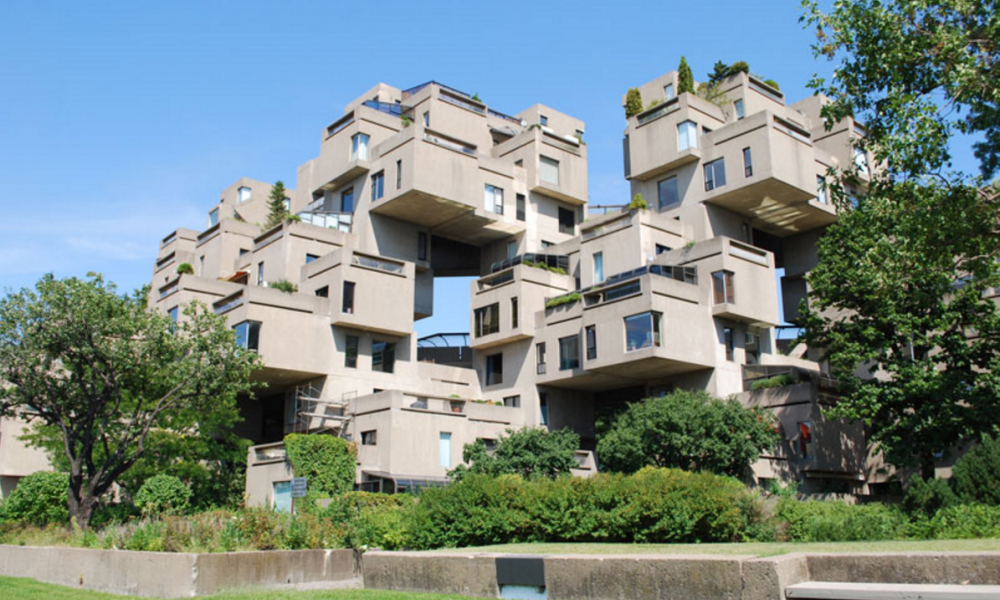Reimagining Urban Architecture
by Diane M. Bolz

Raffles City Chongquing is a mixed-use, 9-million-square-foot complex set at the confluence of China’s Jialing and Yangtze rivers.
In 1967 a 29-year-old Israeli-born Canadian architect by the name of Moshe Safdie gained international recognition for his groundbreaking, visionary design for high-quality, affordable urban housing. The project, known as Habitat ’67, was commissioned by the Canadian government for the Expo 67 World’s Fair in Montreal. Inspired in part by the vernacular of Mediterranean hill towns, the original 158-unit modular apartment complex consisted of a series of stacked and interlocking prefabricated concrete boxes. Featuring terraces, rooftop gardens, private entrances and connecting walkways, the project was based on Safdie’s undergraduate thesis at McGill University. Quickly recognized as a revolutionary architectural experiment, Habitat ’67 (below)catapulted Safdie onto the world stage.
A comprehensive and arresting exhibition, on view from March 16 through May 22 at BSA Space, Boston’s leading center for architecture and design, documents and celebrates Safdie’s diverse achievements. Curated by Donald Albrecht, an independent curator at the Museum of the City of New York, “Global Citizen: The Architecture of Moshe Safdie” presents some 175 photographs, drawings and models that track the course of Safdie’s 50-year career. In particular, says Albrecht, “the exhibition explores what it means to create livable urban spaces.” Before coming to Boston, the exhibit was on display at the National Academy Museum in New York City. The show was originally organized by Arkansas’s Crystal Bridges Museum of American Art and California’s Skirball Cultural Center (both designed by Safdie).
Now headquartered in Boston, Safdie’s firm, which also has offices in Jerusalem, Toronto, Singapore and Shanghai, has designed more than 85 completed buildings, communities and urban plans on three continents. Safdie’s masterful handling of natural light, strong geometric forms and evocative imagery has animated museums, cultural centers, libraries, memorials, housing, schools and religious facilities around the globe.

Bold and innovative, Habitat ’67 in Montreal helped launch Safdie’s prolific 50-year career.
From the National Gallery of Canada in Ottawa and the Yad Vashem Holocaust History Museum in Jerusalem (opposite) to the United States Institute of Peace Headquarters in Washington, DC and the Marina Bay Sands Resort in Singapore (opposite, top), Safdie’s projects reflect his commitment to the integration of architecture and landscape, art and science, and private and public spaces. His belief that buildings should relate to or echo their historic, cultural and environmental settings is key to his design philosophy. Also essential to his approach is the way in which his architecture has invited interaction with community life. “As architects,” he says, “we are responsible for shaping not only a project’s program, but also its larger civic role of enabling and enriching the community.”
The 77-year-old Safdie was born in Haifa during the British Mandate of Palestine. He was 15 and an ardent Zionist on a path to study agriculture when his father, who was from Aleppo, Syria, moved the family to Canada. There his aptitude for math and art led him to the field of architecture. Now a citizen of Israel, Canada and the United States, Safdie has visited every continent and countless countries in connection with his commissions. He has designed housing for the Inuit in the Arctic, structures for West Africans, Sikhs and Muslims, and national institutions for Canada, the United States, Israel and China.

Safdie projects, clockwise from top: The Marina Bay Sands Resort is a 40-acre, mixed-use complex located across the bay from downtown Singapore. The 2011 development features a waterfront promenade, retail, entertainment and civic spaces, a museum, and three 55-story hotel towers topped by a cantilevered “sky garden.” Salt Lake City’s Public Library became a center of civic activity and helped revitalize the city’s downtown. The Yad Vashem Holocaust History Museum in Jerusalem opened in 2005.
“Both geometry and daylight have been formative forces in the shaping of my work,” Safdie explains. “I have devoted much thought and energy to how to shape and form buildings to maximize the exposure to daylight. In some ways, you could say that as an architect, I’ve followed the light. Likewise, geometry is an ordering device that facilitates rational and efficient construction.”
Despite his achievements and the popularity of many of his projects, Safdie remains a controversial figure. “My architecture is not predictable or repetitive,” he says, “which makes it difficult for critics.”

Last year Safdie was awarded the American Institute of Architects’ prestigious AIA Gold Medal. In his acceptance speech, he said, “Humanizing mega-scale is the single most urgent task that awaits us in the decades to come.”
The exhibition in Boston closes with a section titled “Habitat of the Future.” A 21st- century reimagining of Habitat ’67, the display was the result of Safdie rethinking his original project in light of new construction technology, huge population increases and social and cultural shifts. The futuristic models in this section were created for the exhibit and are at once provocative and inspiring—a window on the not-so-far-distant future.
“I have a dream of high-rise cities transformed, penetrated by light and sun, with plant life and gardens on land and sky,” Safdie said in accepting the AIA Gold Medal,“…new centers, integrating culture, commerce and governance into places we can call an urban oasis.”




I remember Moishe and his family as a young girl growing up in Montreal. My father knew Moishe’s family from Syria. Small world! We went to Expo 67 and marveled at Moishe’s ideas so ahead of his time. What amazing contributions you have made to humanity, the places we call home and the buildings you have brought to life.